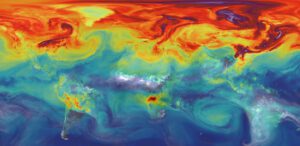
Three-way coupling between chemical, dynamical, and radiative processes could have important effects on climate, including modulation of climate sensitivity. While stratospheric ozone is expected to recover from the effects of ozone-depleting substances over the coming decades, the chemical impact of N2O and CH4 on stratospheric ozone and water vapour will likely increase. Resulting changes in ozone, water vapour, NOx, and HOx will occur simultaneously with changes in stratospheric CO2 and temperature. The increased stratospheric aerosol following strong volcanic eruptions can influence stratospheric ozone and have a strong impact on tropospheric climate. APARC promotes a holistic view of the effect of these concurrent changes in order to understand the implications for climate.
Because the formation pathways for atmospheric aerosols are diverse and complex, resulting in a range of physical and chemical aerosol properties, the simulation of aerosol formation in models is challenging. Resulting uncertainty in aerosol concentrations and properties creates uncertainty in aerosol radiative forcing, particularly the indirect aerosol forcing and its effects through cloud feedbacks.
Radiative forcing from long-lived gases (CO2, CH4, N2O, CFCs, etc.) is well understood. The main uncertainties are associated with (1) future biogeochemical changes in the carbon cycle; (2) natural and anthropogenic emissions of these gases (CH4 especially) and (3) assessing the future emission scenarios of CH4 and N2O. There are also many more unknowns associated with short-lived climate forcers (gases and aerosol) and SPARC promotes activities to reduce their climate-related uncertainties.
Science questions
- How do volcanic eruptions affect atmospheric composition, radiation, and dynamics and what are the effects on surface climate?
- How will tropopause layer cirrus and their associated radiative effects change in a warming climate?
- How does varying solar UV irradiance influence decadal-scale climate?
- What determines the long-term changes in stratospheric water vapour and its feedback on radiative forcing?
- What trends in stratosphere-troposphere exchange have occurred on hemispheric and regional scales and how robust are projections of future trends?
- How does climate change affect transport of stratospheric ozone to the troposphere, and thereby influence tropospheric composition and air quality given expected changes in tropospheric emissions?
- What changes in surface climate can be attributed to interactive atmospheric chemistry? Can the importance of near-term climate forcers be better understood and quantified?
- By what processes, and to what extent, might changes in the chemical composition of the stratosphere influence climate sensitivity?
- How might coupling between changes in atmospheric dynamics and chemical composition affect future climate?
- What are the anticipated regional impacts of solar radiation management approaches such as stratospheric aerosol injection?
Related APARC activities:
- Asian monsoon (ACAM) – joint with IGAC
- CCM initiative (CCMI) – joint with IGAC
- Composition Trends And Variability in the Upper Troposphere and Lower Stratosphere (OCTV-UTLS)
- Data assimilation (DAWG)
- Polar stratospheric clouds (PSC)
- Solar influence (SOLARIS-HEPPA)
- Stratospheric sulfur (SSiRC)
- Towards Unified Error Reporting (TUNER)
